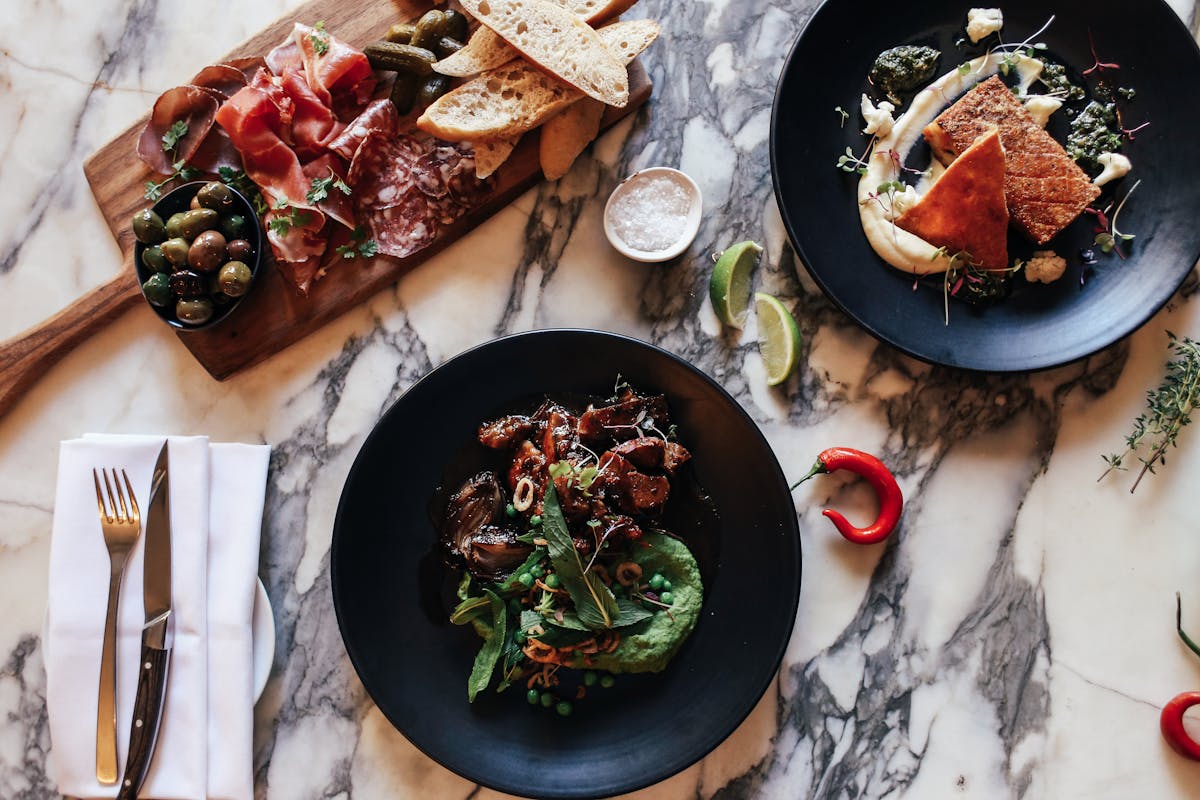
In our fast-paced lives, finding the time and energy to prepare wholesome and delicious meals can be a challenge. However, with some planning and the right recipes, you can create quick and easy meals that will keep you satisfied throughout the week. Weekly meal planning mean planning your or your family’s meals for the week. Simple planning can make life a little easier and healthier, and we are all about that! If you have never attempted meal planning and the idea sounds overwhelming, don’t stress!
How to make a weekly meal plan
Planning can help you have healthy meals and snacks no matter how busy things get.
Here are six ways to make planning part of your weekly schedule:
1. Give yourself time to plan
Set aside time each week to make a meal plan. Keep to it each week. Once you get into the habit of planning, you will need less time. This will save you time in the supermarket and probably reduce food waste, too. Think about:
- How many meals you need to prepare for the week
- When you need to make quick meals or prepare them in advance
2. Check what you have
Before you start, check what ingredients you already have in your cupboard, fridge, or freezer. This may even give you some recipe inspiration. For example, if you have eggs you could make an omelette. Use up vegetables with a stir-fry.
3. Make it fun with favorites
- Make a go-to list of meals that you and your family enjoy
- Introduce new recipes when you have extra time; if it’s a hit, add them to your favorites.
- Get the kids involved and ask them what they would like to eat. Kids are more likely to eat meals that they have helped to plan.
- Try a themed night, for example, Mexican Monday, Italian Tuesday, Fishy Friday, or Something New Saturday.
4. Use up your leftovers
- Plan meals that can be refrigerated and heated up or eaten cold the next day such as pasta bake, soup, shepherd’s pie, curry, lasagne or beef stew.
- Use leftover vegetables in an omelet, soup, or salad, or add leftover meat to a curry or stir-fry.
- Remember, leftovers stored in the fridge must be used within three days.
5. Cook in bulk
- Cook extra and refrigerate or freeze the leftovers. Pies, curries, stews, and casseroles all freeze well.
- If you are using the oven, think about what else you can cook at the same time. If you are doing a casserole, you could cook some chicken breasts to go in sandwiches.
6. Make your ingredients work
- Choose recipes that use the same key ingredients to save time and money by reducing the amount of food you need to buy.
- Introduce variety by picking 2-3 main vegetables and adding them to a meat, pasta, or fish dish. For example, peppers, broccoli, and sweetcorn can be added to a beef stir-fry but can also be used to make a vegetable pasta bake or served with meat or fish.

Get started with quick and easy weekly meal dinner recipes
The following weekly meal recipe ideas should take no more than 20 minutes to cook and prepare, perfect for when you get home from work or with the kids:
- Grilled fish with boiled potatoes and vegetables (try frozen vegetables as they’re quickly cooked in the microwave and create little or no waste)
- Stir-fry some vegetables with some rice or noodles
- Pasta with olive oil, garlic, and chili. Add some grilled chicken or salmon for variety.
In this guide, we will explore a variety of recipes that are not only time-efficient but also bursting with flavor. Whether you’re a busy professional, a parent juggling multiple responsibilities, or simply someone looking for convenient meal options, these recipes will make your weekly meal preparation a breeze.
- One-Pan Chicken and Vegetable Stir-Fry:
- Ingredients:
- Boneless, skinless chicken breasts
- Assorted vegetables (bell peppers, broccoli, carrots)
- Soy sauce
- Ginger and garlic (minced)
- Sesame oil
- Brown rice (optional)
- Instructions:
- Cut the chicken into bite-sized pieces and cook in a pan with sesame oil until browned.
- Add minced ginger and garlic, followed by chopped vegetables.
- Stir in soy sauce and cook until vegetables are tender.
- Serve over brown rice if desired.
- Ingredients:
- Quinoa Salad with Chickpeas and Mediterranean Flavors:
- Ingredients:
- Quinoa
- Canned chickpeas
- Cherry tomatoes
- Cucumber
- Red onion
- Feta cheese
- Olive oil and lemon dressing
- Instructions:
- Cook quinoa according to package instructions.
- Combine quinoa with chickpeas, diced vegetables, and crumbled feta.
- Drizzle with olive oil and lemon dressing, toss, and refrigerate until ready to serve.
- Ingredients:
- Sheet Pan Baked Salmon with Roasted Vegetables:
- Ingredients:
- Salmon fillets
- Baby potatoes
- Asparagus
- Lemon
- Olive oil
- Fresh dill
- Instructions:
- Arrange salmon fillets on a sheet pan surrounded by halved baby potatoes and asparagus.
- Drizzle with olive oil, squeeze lemon juice over everything, and sprinkle with fresh dill.
- Bake until the salmon is cooked through and the vegetables are tender.
- Ingredients:
- Vegetarian Tacos with Black Beans and Avocado:
- Ingredients:
- Corn tortillas
- Canned black beans
- Avocado
- Cherry tomatoes
- Red onion
- Lime
- Cilantro
- Instructions:
- Warm corn tortillas in a pan.
- Fill with black beans, diced avocado, cherry tomatoes, and red onion.
- Squeeze lime juice over the top and garnish with fresh cilantro.
- Ingredients:
- Pasta Primavera with Garlic and Parmesan:
- Ingredients:
- Your favorite pasta
- Mixed vegetables (zucchini, cherry tomatoes, bell peppers)
- Garlic (minced)
- Olive oil
- Parmesan cheese
- Instructions:
- Cook pasta according to package instructions.
- Sauté minced garlic in olive oil, add mixed vegetables, and cook until tender.
- Toss the cooked pasta with the vegetable mixture and top with Parmesan cheese.
- Ingredients:
- Turkey and Spinach Stuffed Peppers:
- Ingredients:
- Bell peppers
- Ground turkey
- Spinach
- Quinoa
- Tomato sauce
- Mozzarella cheese
- Instructions:
- Cut bell peppers in half and remove seeds.
- Brown ground turkey, add cooked quinoa, spinach, and tomato sauce.
- Stuff the peppers with the turkey mixture, top with mozzarella, and bake until cheese is melted.
- Ingredients:
- Easy Chicken Caesar Wrap:
- Ingredients:
- Grilled chicken strips
- Romaine lettuce
- Caesar dressing
- Parmesan cheese
- Whole wheat wraps
- Instructions:
- Lay out the whole wheat wraps and assemble with grilled chicken, lettuce, Caesar dressing, and Parmesan.
- Roll up the wraps, cut them in half, and enjoy a quick and satisfying lunch.
- Ingredients:
- Quick Vegetable Fried Rice:
- Ingredients:
- Cooked rice (preferably day-old)
- Mixed vegetables (peas, carrots, corn)
- Scrambled eggs
- Soy sauce
- Sesame oil
- Instructions:
- Sauté mixed vegetables in a pan, add cooked rice and scrambled eggs.
- Drizzle with soy sauce and sesame oil, stir well, and serve hot.
- Ingredients:
Tips for Efficient Weekly Meal Planning
Efficient weekly meal planning can save you time, money, and effort while ensuring that you and your family enjoy well-balanced and delicious meals throughout the week. Here are some practical tips to streamline your meal-planning process:
- Create a Weekly Schedule: Start by creating a weekly meal schedule that outlines your commitments, such as work, school, and extracurricular activities. This helps you identify busy days when you may need quick and easy meals versus days when you have more time to prepare elaborate dishes.
- Take Inventory of Ingredients: Before planning your meals, check your pantry, refrigerator, and freezer for existing ingredients. This prevents unnecessary purchases and helps you use up items before they expire.
- Plan Theme Nights: Simplify your meal planning by assigning specific themes to different nights of the week. For example, you could have a “Meatless Monday,” “Taco Tuesday,” or “Sheet Pan Wednesday.” This adds variety to your meals and makes planning easier.
- Batch Cooking: Consider batch cooking certain components of your meals over the weekend. Cook grains, roast vegetables, or prepare protein sources in larger quantities, allowing you to assemble quick meals during the week.
- Double Up and Repurpose: When planning meals, think about how you can repurpose ingredients. For instance, if you roast extra vegetables for one meal, use the leftovers in a salad, wrap, or stir-fry the next day. This reduces waste and saves time.
- Keep it Simple: Focus on recipes that are simple and require minimal ingredients. Complicated recipes with a long list of components can be time-consuming and may discourage consistent meal preparation.
- Utilize Leftovers: Embrace leftovers as a time-saving strategy. Plan meals where you can cook once and eat twice. For example, a roast chicken on Sunday can be repurposed into sandwiches, salads, or wraps throughout the week.
- Prep Ingredients in Advance: Spend some time chopping vegetables, marinating proteins, or assembling meal components in advance. Having prepared ingredients on hand makes it easier to throw together meals, especially on busy weeknights.
- Include Convenience Items: Don’t shy away from using convenience items like pre-washed salad greens, frozen vegetables, or pre-cooked grains. These items can significantly cut down on prep time without compromising on nutrition.
- Use a Meal Planning App or Template: Make use of technology to streamline your weekly meal-planning process. There are several meal-planning apps and templates available that can help you organize your weekly meals, create shopping lists, and even suggest recipes based on your preferences.
- Rotate Family Favorites: Keep a list of family-favorite meals and rotate them regularly. This reduces the need to search for new recipes and ensures that you are preparing meals that everyone enjoys.
- Stay Flexible: Life is unpredictable, so be flexible with your meal plan. Have a few backup options or quick recipes for those days when unexpected events disrupt your original plan.
- Shop Strategically: Once you’ve planned your meals, create a shopping list organized by categories to make your grocery shopping more efficient. Stick to your list to avoid unnecessary purchases.
- Plan for Convenience Meals: Accept that there will be days when you don’t have the time or energy to cook. Plan for convenience meals such as frozen pizzas, pre-made salads, or simple sandwiches for those hectic days.
- Reflect and Adjust: At the end of each week, take a moment to reflect on what worked well and what didn’t. Adjust your meal planning strategy accordingly to continuously improve the efficiency of the process.
By incorporating these tips into your weekly meal-planning routine, you can save time, reduce stress, and ensure that you consistently provide your family with nutritious and satisfying meals. Remember, the key is to find a system that works for you and allows for flexibility as life unfolds.
How do I plan a weekly meal for my family?
Planning a weekly meal for your family involves considering preferences, dietary needs, and your schedule. Here’s a step-by-step guide to help you plan a nutritious and enjoyable weekly menu:
Step 1: Take Inventory
- Check Your Pantry, Fridge, and Freezer: Before planning, see what ingredients you already have. This helps you avoid unnecessary purchases and ensures you use items before they expire.
Step 2: Consider Preferences and Dietary Needs
- Ask for Input: Involve your family members in the weekly meal-planning process. Ask for their favorite meals, any dietary restrictions, and if they have specific cravings.
- Consider Dietary Needs: Take note of any dietary restrictions or preferences such as vegetarian, gluten-free, or low-carb options.
Step 3: Create a Weekly Schedule
- Note Your Schedule: Consider your family’s weekly meal schedule. Identify busy days when you need quick meals and days when you have more time for cooking.
- Theme Nights: Assign themes to different nights (e.g., Taco Tuesday, Pasta Night) to add variety and simplify planning.
Step 4: Plan Meals
- Select Main Dishes: Choose main dishes for each day, considering a mix of proteins (meat, poultry, fish, or plant-based) and variety.
- Balance Nutrients: Ensure a balance of macronutrients (proteins, carbohydrates, and fats) and include a variety of colorful fruits and vegetables for micronutrients.
- Plan for Leftovers: Strategically plan for leftovers or ingredients that can be repurposed for subsequent meals to reduce cooking time.
Step 5: Breakfast, Lunch, and Snacks
- Plan Breakfasts: Include easy and nutritious breakfast options such as overnight oats, yogurt parfaits, or smoothies.
- Lunch Ideas: Plan simple and portable lunches, such as salads, wraps, or leftovers from dinner.
- Healthy Snacks: Consider healthy snacks like cut fruits, veggies with dip, or nuts to keep energy levels stable between meals.
Step 6: Mix Familiar with New
- Rotate Favorites: Include family favorites but also try one or two new weekly meal recipes each week to keep things exciting.
Step 7: Create a Shopping List
- Organize Your List: Based on your meal plan, create a detailed shopping list organized by categories (produce, dairy, pantry items, etc.).
- Stick to the List: While shopping, stick to your list to avoid impulse purchases and stay within your budget.
Step 8: Prep Ahead
- Prep Ingredients: Spend some time chopping veggies, marinating proteins, or preparing ingredients in advance for quicker meal assembly.
Step 9: Be Flexible
- Allow for Flexibility: Life is unpredictable. Have a few easy and quick backup meals or plan for a convenient option for days when things don’t go as planned.
Step 10: Reflect and Adjust
- Review and Adjust: At the end of the week, reflect on what worked well and what didn’t. Adjust your plan for the following week based on feedback and experience.
Additional Tips:
- Utilize Time-Saving Appliances: Invest in appliances like a slow cooker, instant pot, or air fryer to make cooking more efficient.
- Keep a Recipe Collection: Maintain a collection of tried-and-true recipes that your family loves. This makes planning easier and ensures a rotation of meals.
- Consider Theme Nights: Incorporate theme nights like “Meatless Monday” or “Soup Night” to simplify planning and add variety.
- Get Creative with Leftovers: Be creative with repurposing leftovers into new meals to minimize food waste.
Remember, the key to successful weekly meal planning is finding a system that works for your family’s preferences and schedule. Be flexible and open to adjustments as you discover what works best for you.
FAQ:
How do you use a weekly meal planner?
Select the meals and snacks you plan to eat for the following week and put them into your calendar. You can use a meal-planning app or a calendar that hangs on your fridge. Create a grocery list that includes any ingredients you need to buy, snacks, and convenience items (for example, instant oatmeal or salad kits).
What is a good daily meal?
The more veggies and the greater the variety the better. Potatoes and French fries don’t count. Choose fish, poultry, beans, and nuts; limit red meat and cheese; avoid bacon, cold cuts, and other processed meats. Eat a variety of whole grains (like whole-wheat bread, whole-grain pasta, and brown rice).
Is chicken and rice a healthy meal?
Chicken and rice are also nutritious options. In addition to being a lean protein, chicken provides the body with vital vitamins, minerals, and other nutrients; rice is a good source of more than 15 essential nutrients, as well.
What is the perfect meal plan?
A clean-eating meal plan includes tons of fresh fruits and veggies, high-fiber whole grains and legumes, healthy fats, and lean proteins (like fish and chicken). It skips added sugars and minimizes sodium and saturated fats that can damage our hearts when we eat too much of them.
Conclusion:
These quick and easy recipes are designed to simplify your weekly meal preparation without compromising on taste and nutrition. Incorporating a variety of ingredients, flavors, and cooking techniques, these meals provide a delicious solution for busy individuals and families. By taking the time to plan your meals and trying out these recipes, you can enjoy homemade dishes that are not only convenient but also a delight for your taste buds. Remember, the key to successful weekly meal planning is versatility, so feel free to modify these recipes to suit your preferences and dietary needs. Happy cooking!
kidsmodelistamagazine
Quick and Easy Recipes for Weekly Meals
Print RecipeIngredients
- Pasta Primavera with Garlic and Parmesan: Ingredients: Your favorite pasta Mixed vegetables (zucchini, cherry tomatoes, bell peppers) Garlic (minced) Olive oil Parmesan cheese
- Vegetarian Tacos with Black Beans and Avocado: Ingredients: Corn tortillas Canned black beans Avocado Cherry tomatoes Red onion Lime Cilantro
- Sheet Pan Baked Salmon with Roasted Vegetables: Ingredients: Salmon fillets Baby potatoes Asparagus Lemon Olive oil Fresh dill
- Quinoa Salad with Chickpeas and Mediterranean Flavors: Ingredients: Quinoa Canned chickpeas Cherry tomatoes Cucumber Red onion Feta cheese Olive oil and lemon dressing
Instructions
-
Plan and Prep: Take some time to plan your meals for the week. Create a shopping list and buy all the ingredients you need.
-
Batch Cooking: Prepare ingredients that can be used in multiple meals. For example, you can cook a batch of quinoa or brown rice to use in different dishes throughout the week.
-
Multitasking: When cooking, try to multitask. For instance, while the chicken is grilling, you can chop vegetables for the salad.
-
Portion Control: Consider portioning meals for the week, making it easier to grab a ready-made lunch or dinner.
-
Leftovers: Embrace leftovers as they can save time. Cook extra portions and refrigerate or freeze for later in the week.
-
Easy Swaps: Feel free to customize recipes based on your preferences or what’s available. Swap proteins, use different vegetables, or adjust seasonings.
-
Cook Once, Eat Twice: If a recipe makes more than you need, find creative ways to repurpose it. For example, use leftover grilled chicken in a wrap or a salad.


































